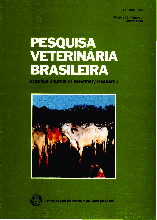 |
|
|
|
Year 2000 - Volume 20, Number 3
|

|
Experimental monensin poisoning in horses, 20(3):102-108
|
ABSTRACT.- Bezerra Jr P.S., Ilha M.R.S., Langohr I.M. & Barros C.S.L. 2000. [Experimental monensin poisoning in horses.] Intoxicação experimental por monensina em eqüinos. Pesquisa Veterinária Brasileira 20(3):102-108. Depto Patologia, Universidade Federal de Santa Maria, 97105- 900 Santa Maria, RS, Brazil. E-mail: cslb@sm.conex.com.br
Seven horses were experimentally treated with sodium monensin. Two of them were fed 3-4 kg/horse/daywith a commercial ration (containing 180 ppm±20) known to be implicated in natural outbreaks of monensin poisoning in horses. A third horse was fed a single dose of 5 mg/kg and another one received four daily doses of 1 mg/kg of sodium monensin (from a premix source). These four horses died or were euthanitised in extremis 3-8 days after the beginning of administration of the drug. A fifth horse was fed a single dose of 5 mg/kg of monensin, became mildly ill but recovered. Two experimental horses did not develop signs of the toxicosis. One of them was fed 40 daily doses of 0.5 mg/kg of monensin. The other was fed 3 kg/day of the sarne brand of ration used in farms where outbreaks of monensin poisoning in horses have been reported (but from another batch later determined to have monensin leve Is of only < 5 ppm). The onset of clinical signs varied from 2 to 5 days after administration of the drug, and clinical courses lasted from 24 to 76 hours. Clinical signs included tachycardia and cardiac arythmia, groaning, incoordination, sudoresis, sternal or lateral recumbency, paddling and death. Ma.rked increases in the plasmatic activity of creatine phosphokinase were observed in five poisoned horses, and a mild increase in the aspartate aminotransferase plasmatic activity was detected in one of the animals. Main necropsy findings were in the skeletal muscles and consi_sted of focal to focally extensive white or yellow areas of discoloration with bilateral symmetric distribution. These lesions were associated with gelatinous transluscent edema in the intermuscülar fasciae. More intensively affected muscles included quadriceps femoris, adductor, pectineus, gracilis, semimembranous, supraspinatus, subscapularis and brachycephalic. Histopathological findings consisted of segmentar, multifocal to coalescent, degenerative myopathy. Both gross and microscopic lesions were absent in the skeletal muscles from two of the horses fed the monensin premix [5 mg/kg (single dose) and 4 mg/kg (four daily doses of 1 mg/kg)]. Neither gross nor microscopic lesions were observed in the myoéardium of any of these horses. |
| |
|
|
| |
|
 |